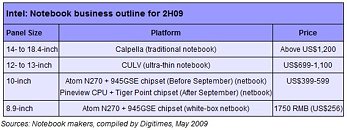- Joined
- Oct 9, 2007
- Messages
- 47,675 (7.43/day)
- Location
- Dublin, Ireland
| System Name | RBMK-1000 |
|---|---|
| Processor | AMD Ryzen 7 5700G |
| Motherboard | Gigabyte B550 AORUS Elite V2 |
| Cooling | DeepCool Gammax L240 V2 |
| Memory | 2x 16GB DDR4-3200 |
| Video Card(s) | Galax RTX 4070 Ti EX |
| Storage | Samsung 990 1TB |
| Display(s) | BenQ 1440p 60 Hz 27-inch |
| Case | Corsair Carbide 100R |
| Audio Device(s) | ASUS SupremeFX S1220A |
| Power Supply | Cooler Master MWE Gold 650W |
| Mouse | ASUS ROG Strix Impact |
| Keyboard | Gamdias Hermes E2 |
| Software | Windows 11 Pro |
Intel has everything going its way when it comes to mobile computing, and the processors it sells that power notebooks and netbooks across every segment of the market. Intel uses the common classification of portable computers (consumer segment), using sizes and form-factors to differentiate mainstream notebooks, performance notebooks, ultra-thin notebooks, "larger" sub-notebooks (netbooks), and common entry-level netbooks. To cater to each of these, Intel made things easier by coming up with platforms (sets of processor and chipset combinations), a market approach both Intel and AMD have been using recently.
Starting with mainstream, and performance notebooks (traditionally above 14-inches in size, above US $1200 in price), Intel has the Calpella platform, that marks the entry of Nehalem architecture to the mobile scene. This is slated for 3Q 2009. Intel will simultaneously lower the prices of its current Montevina platform, to let inventories digest. Major hardware manufacturers are preparing their "launch-vehicles" for the Calpella platform, which will make it in time for Q3 2009.
Moving on to ultra-thin (sizes 12~14 inch,) this is a segment that has recently emerged. Apple Macbook Air and Dell Adamo are poster-boys for it. Intel will continue to develop more CULV chips, ultra-low voltage derivatives of the current 45 nm Montevina platform.
Finally to the fastest growing market segment, Intel has quite some plans to cater to the ULPC (sub-notebooks). Intel sub-classifies the segment into two: the ~10-inch sub-class ($399-599), and the entry level 8.5-inch (around $256) sub-class. To cater to the 10-inch class, Intel has plans for sticking with Atom N270 and i945GSE chipset before September, while announcing the next-generation Pineview CPU with Tigerton chipset (codename for Atom successor based on newer Core architecture). The 8.5-inch segment continues to use Atom N270 and i945GSE. These are whitebox netbooks that will feature 512 MB of memory, and 8~16 GB of NAND-flash based storage, along with support for Moblin v2.

View at TechPowerUp Main Site
Starting with mainstream, and performance notebooks (traditionally above 14-inches in size, above US $1200 in price), Intel has the Calpella platform, that marks the entry of Nehalem architecture to the mobile scene. This is slated for 3Q 2009. Intel will simultaneously lower the prices of its current Montevina platform, to let inventories digest. Major hardware manufacturers are preparing their "launch-vehicles" for the Calpella platform, which will make it in time for Q3 2009.
Moving on to ultra-thin (sizes 12~14 inch,) this is a segment that has recently emerged. Apple Macbook Air and Dell Adamo are poster-boys for it. Intel will continue to develop more CULV chips, ultra-low voltage derivatives of the current 45 nm Montevina platform.
Finally to the fastest growing market segment, Intel has quite some plans to cater to the ULPC (sub-notebooks). Intel sub-classifies the segment into two: the ~10-inch sub-class ($399-599), and the entry level 8.5-inch (around $256) sub-class. To cater to the 10-inch class, Intel has plans for sticking with Atom N270 and i945GSE chipset before September, while announcing the next-generation Pineview CPU with Tigerton chipset (codename for Atom successor based on newer Core architecture). The 8.5-inch segment continues to use Atom N270 and i945GSE. These are whitebox netbooks that will feature 512 MB of memory, and 8~16 GB of NAND-flash based storage, along with support for Moblin v2.

View at TechPowerUp Main Site
Last edited:
